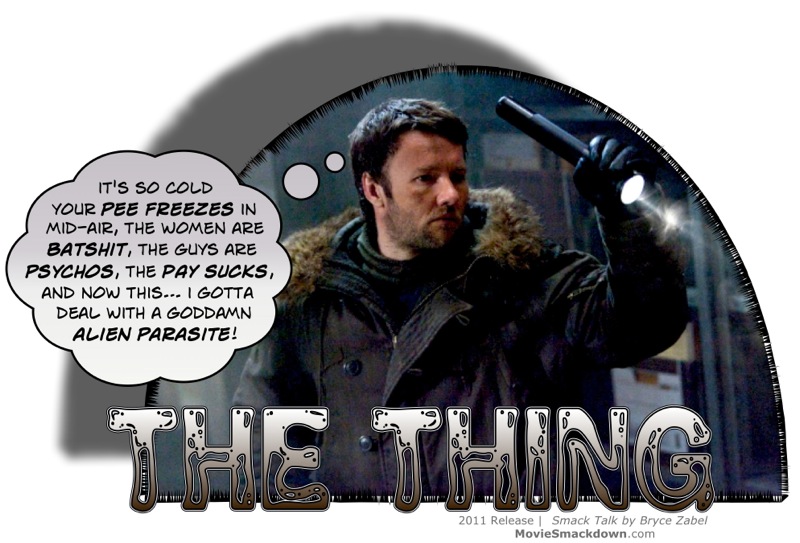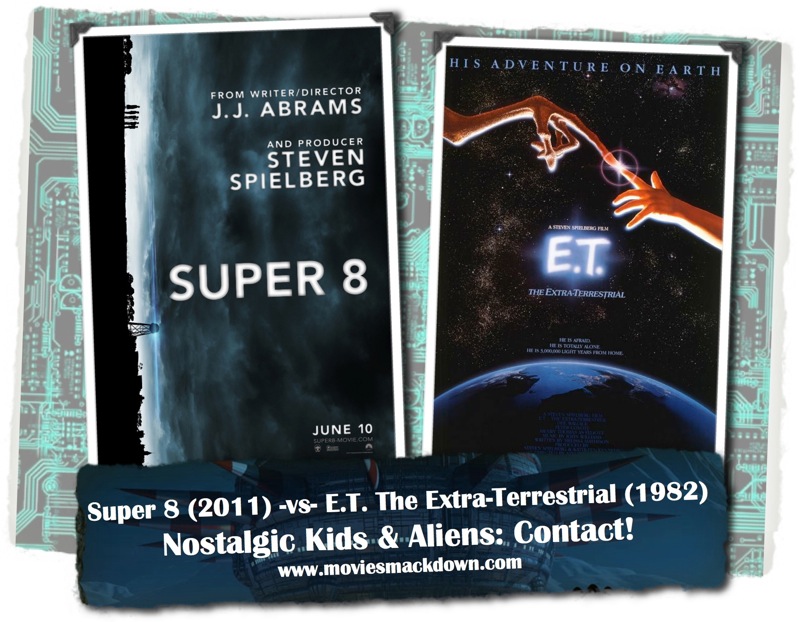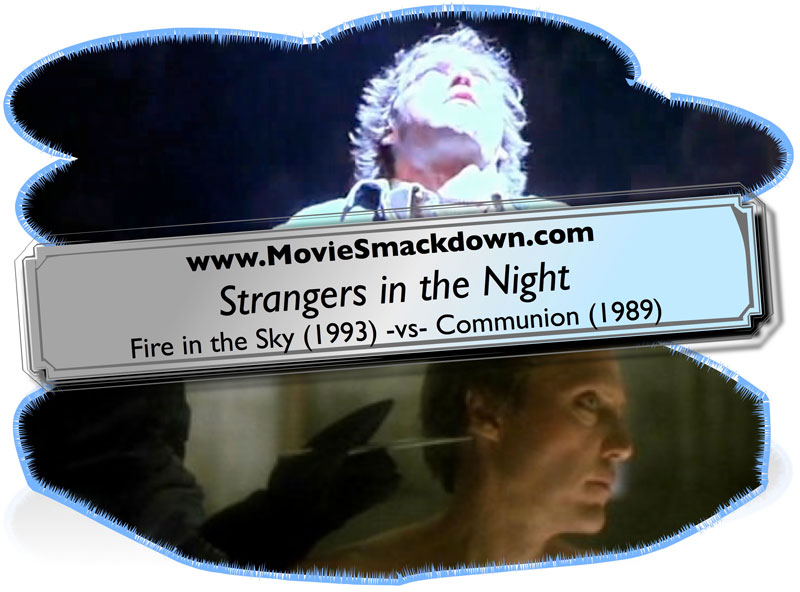
The Smackdown
Despite what some UFOlogists believe — that Hollywood has been enlisted in some kind of unofficial “disclosure” drive about space visitors — don’t look for commercial films to tell you the actual truth about close encounters of any kind. On the one hand, we’ve had the space brothers who have come to help us save the planet and ourselves (Close Encounters of the Third Kind, The Day the Earth Stood Still).  On the other hand, we’ve had the cosmic badasses who’ve come to create hell on Earth (War of the Worlds, Independence Day). The three films in the ring today each suggest another alternative. The aliens are here for purposes that are more mysterious and/or unknowable. They’re not cuddly scientists like E.T. but bizarre and harsh. Our latest contender, The Fourth Kind — as well as the earlier Communion and Fire in the Sky — tells us that they’re here taking people out of their homes and neighborhoods in the middle of the night, tagging them like deer in a Lyme disease study, probing and poking them in ways that suggest rape as much as anything else.
We have two decisions to make here — as we continue our film exploration of alien contact — namely, which version comes closest to what might be the truth about alien intentions here on Earth, and which one is the better film?
[singlepic id=668 w=320 h=240 float=right]
The Challenger
The Fourth Kind, of course, wants to be compared to Steven Spielberg’s Close Encounters of the Third Kind so much that it uses our understanding of the preceding film to hype itself as being something beyond even that. It’s winking that if 3 means “contact” then 4 means something even weirder. It further wants audiences to believe that director Olatunde Osunsami has found shocking and real footage from taped interviews, hypnosis sessions, and police cams in sufficient quantity and quality to use it as the basis of his film.
The story is all about explaining the allegedly strange case of Nome, Alaska psychiatrist Abigail Tyler, who, while living in this isolated part of the world, was witness to alien visitations through her patients. Using that video footage that supposedly documented these extra-terrestrial struggles, Osunsami has actress Milla Jovovich start us off by saying that she’ll be portraying the role of Abigail and literally cuts back and forth between the “real” footage and the recreations all the way through, in many instances literally running them side-by-side. By thus blending the these two worlds, The Fourth Kind seeks to have us believe it has developed a true and comprehensive portrait of some mysterious Nome incidents that are again, supposedly, based on real events. If so, then it’s adding quite a bit to the alien abduction hypothesis, like post-abduction exorcist-like possession, roots to ancient Sumerian visitations, and levitation days after the aliens have left the scene.
[singlepic id=79 w=320 h=240 float=right]
The Defending Champion
Fire in the Sky tells the story of Arizona woodcutter Travis Walton who was, allegedly, abducted into a spacecraft in the mid-70s in full view of his crew. They were returning from a job, late at night, when they all saw the same thing: a physical craft, hovering in the air above them quite close, full of lights and structure. Walton went out to take a look, ended up in a beam of blue light and disappeared. His friends ran in fright. Walton was gone for five days, causing authorities to suspect his co-workers of murder. When he returned, he had a spectacular story about being inside an alien craft. Before you get all skeptical on us, you should know that Walton and his crew all passed lie detector tests.
The film version stars D.B. Sweeney as Walton, in a script from Tracey Torme who’d already made a name for himself in the UFO genre with the CBS miniseries Intruders. As a personal aside, I remember, as a near-graduate in broadcasting at the time, covering this story based on the dispatches from the Zodiac News Service while doing the “news” at Eugene’s hippie FM station, KZEL. The story in my mind turned out to be different than the film they made. The film is about 80% centered on the five witnesses who didn’t get abducted. Instead of facing scary-ass alien abductors, these rough tree-cutting dudes have to face the folksy and skeptical lawman Frank Watters played by James Garner.
[singlepic id=46 w=320 h=240 float=right]
The First Challenger
Communion (the book) stands with The Interrupted Journey (the incredibly well-documented Betty & Barney Hill case from the early 1960s) and Missing Time (Budd Hopkins seminal work) as one of the three pillars in the UFO abduction literary genre. Released in 1986, Communion rocketed up the best-seller list, stayed there, and scared millions. Written by the brilliant writer Whitley Strieber, known for his fiction work, it was presented as a non-fiction account of his interactions with alien creatures. It wasn’t a one-off adventure for the author, though. He’s devoted himself to a collection of books about this topic, submitted to lie detector tests himself, plus psych evaluations and relentless public scrutiny, and through it all, he’s stuck with the story and put it in a context that feels compelling and truthful. What he says is simply this: that he has been repeatedly taken from his home by the now common alien type, the Grays, and that they have spoken to him through a form of telepathy, even while treating him like an uninvited guest with no manners whatsoever. Great as the book was, however, the film was plagued by low budget, awful special effects, a neophyte director, crazy Christopher Walken as Strieber, and problems on that set that rumors surround to this day. Despite all that, it has its moments where it disturbs you, makes you jump, and fires your imagination.
The Scorecard
In an earlier Smackdown, Fire in the Sky won a close-call against Communion. It took more liberties with the actual abduction truth, but it was the superior film. Neither one of them, however, came close to the cinematic triumph of, say, Close Enounters of the Third Kind. And now, as we said at the beginning, we’ve added a third film to the mix to change things up yet again.
A word about truth… let’s start, as Socrates suggested, with a definition. For our purposes, “truth” is what the vast preponderance of witness testimony and researcher findings about high-profile cases seems to say is a consistent reality to abductions. You may not agree that abductions are real (but you should) but even if that’s your opinion, we’re matching these films against what appears to be an emerging reality in the UFO literature that has appeared with more and more specifics since the 1980s.
Based on this definition, The Fourth Kind is not true. It is one of those “found footage” scarefests like Paranormal Activity and Blair Witch Project which uses the idea that it is true, to confuse audiences and make them relate to it. But — I’ll say this again — there is no evidence out there now that The Fourth Kind is based on true fact. People have looked into it, trying to find cases in Nome, Alaska, or even a trace of this so-called psychiatrist that Milla Jovovich is supposed to be channeling. So far, it doesn’t exist. This makes it just another cinematic con job with some marketing geniuses at the studio patting themselves on the back for their brilliant “viral” campaign.
This is unfortunate for two reasons. First, it makes the film a sham within a sham. Second, it minimizes the true suffering many thousands of people appear to have undergone through these experiences. The best anyone can come up with is that a higher than normal amount of people in Nome have gone missing over the years, probably due to alcohol abuse and isolation, but nobody appears to have told anyone prior to going missing that they were suffering abduction in the night. Anyway, based on the abductions that have real gravitas behind them, these aliens are not possessing people, nor are the people so afflicted capable of levitation from their beds, as portrayed in The Fourth Kind. These are movie creations.
Yet how “true” are “Fire in the Sky” and “Communion?” Well, if you look into the matter, the answer is — whether you are ready to accept it or not — pretty true, in general. I qualify this only because both of the films were true in the sense that they are based on real verifiable cases with witnesses who can be found and talked to and who have passed lie detector tests (unlike the missing witnesses of the supposedly true “The Fourth Kind.”) They are less-than-true in that, in one case, the filmmakers have hyped up the abduction details to make them more sensational than they already were and, in another case, the filmmakers tried to put things on film that were simply beyond their special effects grasp.
However, let’s re-state this:  the central characters in each — Whitley Strieber (Communion) and Travis Walton (Fire in the Sky) — have both passed lie detector tests.  Show me a Hollywood agent who could do that about today’s phone list, and you’ll begin to appreciate the accomplishment.
The screenwriter of Fire in the Sky, Tracy Torme, is a friend of mine, and he’s always been disturbed that the abduction scene in his film was forced on him by the studio (supposedly Brandon Tartikoff), and goes beyond the direct testimony and memory of Travis Walton. Regardless, it’s a riveting, repellant, horrific look at abduction that will scare you because you’ll see what it would be like to be a human being treated with the same kind of distant disregard that we treat animals we are studying. But it’s not any more “true” than the possessions of The Fourth Kind or so it seems.
The point I’m making though is this:Â The Fourth Kind looks true, but isn’t, while Communion and Fire in the Sky look fake, but aren’t, more or less.
So that’s the truth angle… now let’s look at them as films…
The oldest (1989) is Communion. The low-budget look of the film made from Strieber’s book just shouts “phony” with its little blue aliens who can barely move, but is actually based on a horrifying testimony from the author.
Next up (1993) is Fire in the Sky, the film made from Walton’s book of the same title. It looks astonishing in the abduction sequences that are apparently amplified to boost the film’s box office. Industrial Light and Magic did the special effects for Fire in the Sky.
Finally, we have The Fourth Kind, which is the best-looking of the lot, which isn’t saying much. Director Olatunde Osunsami seems taken by himself and his subject and seems to be trying a bit too hard while showing a shade too little. The problem is that this is most self-competing film you may ever see. When the original and the recreation are constantly on-screen at the same time, the effect created is to destroy the reality of both of them.
As for acting, let’s put Milla Jovovich up against D.B. Sweeney against Christopher Walken.
Jovovich is better than I expected — not the complete dud that some critics have painted her as — but she is held back by a confusing script that plays with the audience’s heads with more conviction than it tells its story. Among the earlier efforts, Christopher Walken is just more creepy to watch in Communion than D.B. Sweeney is in Fire in the Sky. Sweeney comes across as a TVÂ movie actor in his set-up scenes, while Walken makes you feel you’re in a horror film where they’ve locked the doors. The winner: Â Christopher Walken.
Fire in the Sky, however, has a strong supporting cast, lead by Robert Patrick, but there is the James Garner-factor that takes you out of it a bit. And much as these actors try, the truth is the real action is with Travis Walton on board the ship, and we get very little of that and very late in the game. Will Patton, however, is, as usual, pretty good in The Fourth Kind.
I guess I’m just mad at The Fourth Kind. Here, the filmmakers had the entire frightening and contemporary run of abduction cases to pick from, and instead, they make one up out of thin air, adding blatant mis-representations, and then try to palm it off as the truth. Maybe they’re paid stooges of government disinformants, that would be the paranoid way to look at it, but I just think they took the wrong turn and kept going. I can’t reward that misguided effort with a win. They built a competent house but with the wrong blueprints, while the other guys had a good plan and built a home with a leaking roof.
All the films do leave you wondering about why extra-terrestrials (or extra-dimensionals) would want much to do with writer Whitley Strieber or logger Travis Walton or the Nome possessees, who never seem to become real characters. On the other hand, when we’re tracking a moose in the Alaskan wilderness to study its migration pattern, do we really distinguish one moose from another?
The Decision
As you know by now, I happen to believe personally that aliens have already come to Earth and are here now. To the extent that the abduction phenomenon is real (some cases obviously are, while many others have other psychological causes), it’s possible that all of these films have elements of the truth within in. My reading convinces me that there are probably two or three types of “visitors” that have tested out humans from time to time.
MOST TRUTH. None of the abduction cases I’ve heard about seem to be like the ones portrayed in The Fourth Kind. On the actual limited standard of just the authenticity of the abduction phenomenon and not the rest of the film, show goes to The Fourth Kind, place goes to Fire in the Sky and win goes to Communion.
BEST FILM. This leaves us with the question, which film is the best one? I wanted to like Communion (and in fact, there are things to like there, like the score by Eric Clapton), but it is so terribly undermined by the unintended comical attempts to show us the trauma Strieber underwent that it just can’t be recommended, and it comes in third place. Second goes to The Fourth Kind which, in places, really seems to be on the verge of being an effective horror film, only to fade back on itself and undermine its own fright by not letting us truly see what’s going on. Fire in the Sky, on the other hand, is at least a minimally acceptable movie through and through, a little soft in more than a few places, but hard-edged and intense in a place where it counts. Even though its abduction sequence is not as Walton described it, man, it’s one hell of a riveting few minutes (that you can see on YouTube).
So we have to stick with the defending champion. It’s deeply flawed, but it’s the best of a compromised bunch here, and the winner is still Fire in the Sky.




Leave a Reply